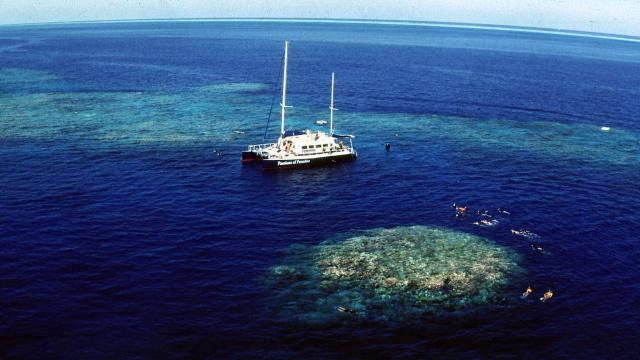The past few months have brought another rough summer for the Great Barrier Reef, which is suffering a major bleaching event for the second year in a row.
Image: AP
Australian coral reef experts made that conclusion after flying over the Great Barrier Reef for six hours yesterday, according to a press release issued by the Great Barrier Reef Marine Park Agency (GBRMPA). Coral can survive bleaching events, but rising sea surface temperatures have caused some to worry about the long term outlook for these biodiverse regions.
The Great Barrier Reef is the world’s largest reef and “largest living structure”, a 2300km expanse of colourful coral hosting thousands of species of fish, molluscs, jellyfish and other sea creatures. These coral rely on microscopic algae embedded in their tissue to produce food via photosynthesis.
But if the water gets too warm or polluted, those algae can be expelled. The starving coral then turns bone white and becomes more susceptible to disease. If the coral dies, it will turn a nasty greenish-brown as other opportunistic algae grow on its surface.
Last year’s warm water brought coral bleaching events worldwide, which were made worse by the El Niño climate pattern, according to a story published last year in the Guardian. This year’s reports are fairly unsurprising — we’ve basically been experiencing the same continuous global coral reef bleaching event since 2014, Mark Eakin, Coordinator of NOAA’s Coral Reef Watch program explained to Gizmodo.
Great Barrier Reef Marine Park rangers started receiving reports back in January that the coral wasn’t looking too good this year. By February, corals were starting to show signs of stress from elevated water temperatures. Yesterday’s survey of the central third of the Reef’s length revealed severe bleaching; this area largely escaped last year’s event, according to the GBRMPA.
The problem with years of successive bleaching is that corals have little time to recover in between. Authorities have pointed to carbon emissions as the probable cause and have cited cutting emissions as the best solution to fix their ailing coral reef.
“It’s vital the world acts to implement the Paris Agreement to reduce greenhouse gas emissions,” said Marine Park Authority Director of Reef Recovery David Wachenfel in the press release.
But even the Paris Agreement might not even be enough to save corals. “You may remember the Paris Agreement talks about staying under 2 degrees of warming,” said Eakin, with an aspirational goal of keeping below 1.5 degrees of warming. “The problem for coral is that 1.5 degrees is all the they can handle. We’re already up one degree and look what’s already happening.”
On top of climate change, more local issues threaten reefs, Eakin explained. “In many areas, people are causing declines in coral reefs because of pollution, overfishing, and habitat destruction,” he said. “We have to be reducing the amount of CO2 in the atmosphere and addressing the local stressors so the coral can have the best chance to survive.”
The GBRMPA will send scientists and experts to survey the remaining length of the reef later this month.
[GBRMPA]
